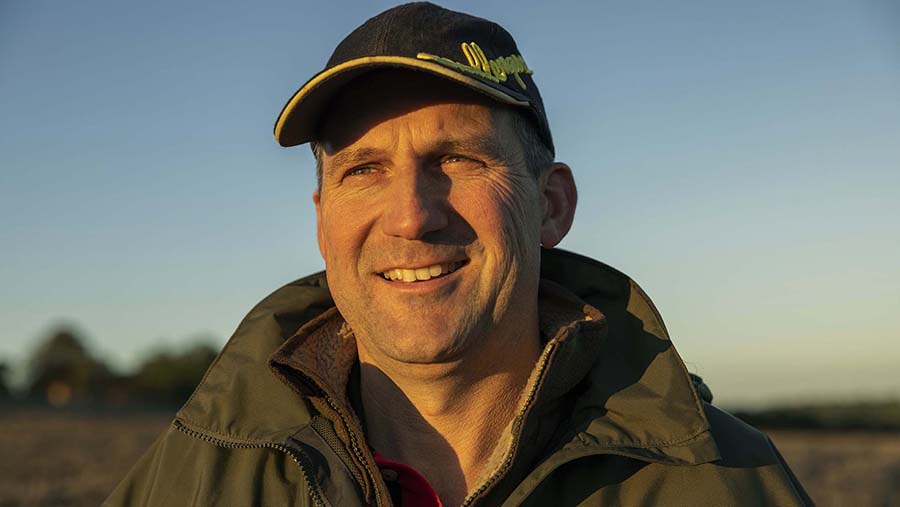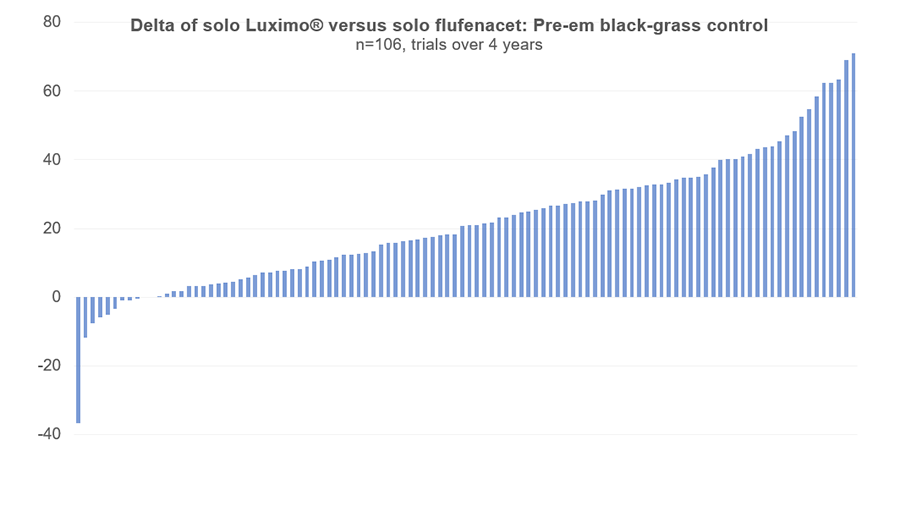Advertiser content
Grower turning the tide on blackgrass
Tom Sewell farms 1200 acres near Maidstone in Kent and is probably best-known for his work on improving his farm’s soil health, having won Soil Farmer of the Year in 2021.
This year, however, blackgrass is competing for his attention.
“We’ve had the worst blackgrass ever,” concedes Tom. “It’s our own fault. Having had two wet autumns in 2019 and 2020, this year, when we got good conditions at the end of September, we decided to drill. With hindsight, that was a week too early and there was still plenty of blackgrass yet to chit.”
“We have used a sulfonylurea in the past, but in 2020 we found it acted more like a PGR than a herbicide. It just checked blackgrass growth and kept it below the canopy. Dropping that from our herbicide programme has unmasked issues that we probably already had,” he notes.
The plan for this autumn
Having been no-till since 2014, Tom is extremely reluctant to plough. Instead, he’ll be delaying drilling and using his rotation to bring populations down.
“Delaying drilling is partly why we’ve recently invested in a bigger drill – when the time comes it’ll allow us to cover more ground more quickly,” he says.
“Last year one field which we didn’t sow until May, meant we got to spray off a chit in February and another in late April – that cleared a lot of blackgrass. That field barely has any weeds. Going forward, delaying spring crops will become part of our armoury too.”
Winter wheat will be established following light cultivations, designed to disturb only the top 5-10mm of soil. And where blackgrass is a notable issue, Tom is aiming for two stale seedbeds but admits he is walking a fine line.
“The no-till drill is quite heavy so once it gets wet, it’s game over. It means we need to drill when its dry….but then when we get rain and the blackgrass chits in the crop. It’s a catch 22. What we really need is rain after harvest, to be able to cultivate lightly, time to wait for the blackgrass to grow, spray and then drill.”
Tom’s current rotation is first wheat followed by a break-crop of either oilseed rape, winter beans, spring beans, spring linseed or spring oats.
Having experimented with a range of cover crops, he is now scratching the surface with a heavy rake in autumn to prompt volunteers to grow. It’s cheaper and more reliable than multispecies mixes, he explains.
“Where the blackgrass is really bad we’ll do continuous spring crops until we’ve the upper hand,” he continues. “The oats are particularly good at smothering any blackgrass.”
Luximo® tramline trial
When it comes to herbicides, Tom’s programme has historically been based around flufenacet and diflufenican. Now, having hosted a Real Results trial this year, Luximo® will feature.
“There were noticeably lower populations of blackgrass on the tramlines treated with the Luximo in comparison with those that received the farm standard,” says Tom.
“And that’s just in the first year. Like any new tool, it takes time to work out how to get the best from it. It’s going to be very useful, and an important part of the whole package.”
New mode of action
Jonnie Dennis, the BASF Agronomy Manager that has been working with Tom on the trial agrees: “Over the last 10-15 years, as an industry, we’ve been forced to rely on flufenacet. It’s the mainstay of programmes and we’re now applying high grams of the active each year. It’s not sustainable.
“The situation makes Luximo’s new mode of action even more important, not only for resistance management but for grassweed management too.”
Across 106 trials over four years, Luximo® provided on average an additional 20% points of control of blackgrass over flufenacet and offered those higher levels of control, more consistently.
“Luximo is a real step forward and we’re seeing it perform in some very difficult situations,” adds Jonnie.
“The label is now out and the application recommendations are similar to those of other residual herbicides – apply Luximo to a fine firm seedbed with moisture, ensuring seed has been drilled to a good depth. Getting the best from Luximo, however, will always start with cultural controls – delayed drilling and stale seedbeds are critical. Use spring cropping where you need to.”
Weed control in a no-till system
“I understand why Tom wouldn’t plough – it would undo all the hard work he has put in– but in conventional systems, good ploughing has been shown to remove up to 90% of blackgrass. It’s also worth noting that bad ploughing can be worse than doing nothing.”
Jonnie recognises that while there are disadvantages to no-till in terms of weed control – for example, difficulty in getting residual products to hit the target,– there are advantages too: “With Tom’s care and attention to soil health, he has eliminated his plough pan and has achieved drainage to depth. As blackgrass thrives in wet conditions, from this perspective, Tom’s approach will be benefiting grassweed control.
“There’s also a benefit from crop competition. With better soils and drainage, he has healthier plants which will also be contributing to his blackgrass control.
“Ultimately, Tom, like all growers, is treading a fine line and balancing a wide variety of, sometimes conflicting, objectives.”
Find out more about Luximo®
For more information on Luximo, please visit our website.
Use plant protection products safely. Always read the label and product information before use.
For further product information including warning phrases and symbols refer to www.agricentre.basf.co.uk.
Luximo® is the brand name for the active ingredient cinmethylin. Luximo® is a registered trademark of BASF.
©BASF 2022. All rights reserved.
Provided by
BASF offers renowned and innovative fungicides, herbicides, insecticides and growth regulators for agriculture. Our products and services help farmers increase their yields and optimize the quality of their products.


